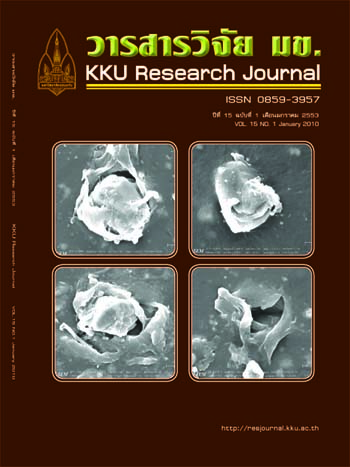Effect of prednisolone in treatment of patients with nephrotic syndrome (Thai)
Main Article Content
Abstract
Patients with nephrotic syndrome normally experience massive proteinuria, hypoalbuminemia, edema,
and hyperlipidemia. There is a treatment guideline for pediatric patients with nephrotic syndrome, but no
guideline has been set for adult patients. Prednisolone is the drug of choice for treatment since it is an immuno-
suppressive agent and also can decrease proteinuria. The objectives of this retrospective study are to investigate
the effect of prednisolone in adult patients with nephrotic syndrome. Time of response and side effects of
prednisolone during the treatment were also evaluated. Patients aged more than 15 years old with nephrotic
syndrome and treated with prednisolone during 1999-2008 at Phramongkutklao hospital, Thailand were enrolled
in this study. There were totally 75 subjects, 48 male and 27 female aged between 18-76 years old (mean age
38.47
±
15.28 years). Sixty-eight patients (90.7%) were classified as having primary nephrotic syndrome.
According to renal biopsy, primary nephrotic syndrome patients can be divided into subtypes of IgM nephropathy
(12 patients or 16%), minimal change nephropathy (MCN) and IgA nephropathy (7 patients each or 9.3%),
membranous nephropathy (6 patients or 8%), focal segmental glomerulosclerosis (2 patients or 2.7%),
membranoproliferative nephropathy (1 patient or 1.3%) and non-identified primary nephrotic syndrome
(33 patients or 44%). There are 7 lupus nephritis patients (9.3%) which is considered as a secondary nephrotic
syndrome. Response of treatment can be determined by monitoring the reduction in urine protein during
a 24 hour period or urine protein/creatinine index or urine protein dipstick test. The response rate is 81.3%
and primary nephrotic syndrome patients respond better to prednisolone compared with secondary nephrotic
syndrome patients (83.8% versus 57.1%). The IgA group has the best response among all subtypes while the
highest complete remission is found in MCN (71.4%). Time of response to prednisolone is 5-8 weeks.
About 23 percent of patients experience the side effects of prednisolone and the most common side effect
is pneumonia (6.7%).
and hyperlipidemia. There is a treatment guideline for pediatric patients with nephrotic syndrome, but no
guideline has been set for adult patients. Prednisolone is the drug of choice for treatment since it is an immuno-
suppressive agent and also can decrease proteinuria. The objectives of this retrospective study are to investigate
the effect of prednisolone in adult patients with nephrotic syndrome. Time of response and side effects of
prednisolone during the treatment were also evaluated. Patients aged more than 15 years old with nephrotic
syndrome and treated with prednisolone during 1999-2008 at Phramongkutklao hospital, Thailand were enrolled
in this study. There were totally 75 subjects, 48 male and 27 female aged between 18-76 years old (mean age
38.47
±
15.28 years). Sixty-eight patients (90.7%) were classified as having primary nephrotic syndrome.
According to renal biopsy, primary nephrotic syndrome patients can be divided into subtypes of IgM nephropathy
(12 patients or 16%), minimal change nephropathy (MCN) and IgA nephropathy (7 patients each or 9.3%),
membranous nephropathy (6 patients or 8%), focal segmental glomerulosclerosis (2 patients or 2.7%),
membranoproliferative nephropathy (1 patient or 1.3%) and non-identified primary nephrotic syndrome
(33 patients or 44%). There are 7 lupus nephritis patients (9.3%) which is considered as a secondary nephrotic
syndrome. Response of treatment can be determined by monitoring the reduction in urine protein during
a 24 hour period or urine protein/creatinine index or urine protein dipstick test. The response rate is 81.3%
and primary nephrotic syndrome patients respond better to prednisolone compared with secondary nephrotic
syndrome patients (83.8% versus 57.1%). The IgA group has the best response among all subtypes while the
highest complete remission is found in MCN (71.4%). Time of response to prednisolone is 5-8 weeks.
About 23 percent of patients experience the side effects of prednisolone and the most common side effect
is pneumonia (6.7%).
Article Details
How to Cite
Namviriyachote, N., Supasyndh, O., & Aramwit, P. (2017). Effect of prednisolone in treatment of patients with nephrotic syndrome (Thai). Asia-Pacific Journal of Science and Technology, 15(1), 67–76. retrieved from https://so01.tci-thaijo.org/index.php/APST/article/view/83141
Section
Research Articles
References
-

